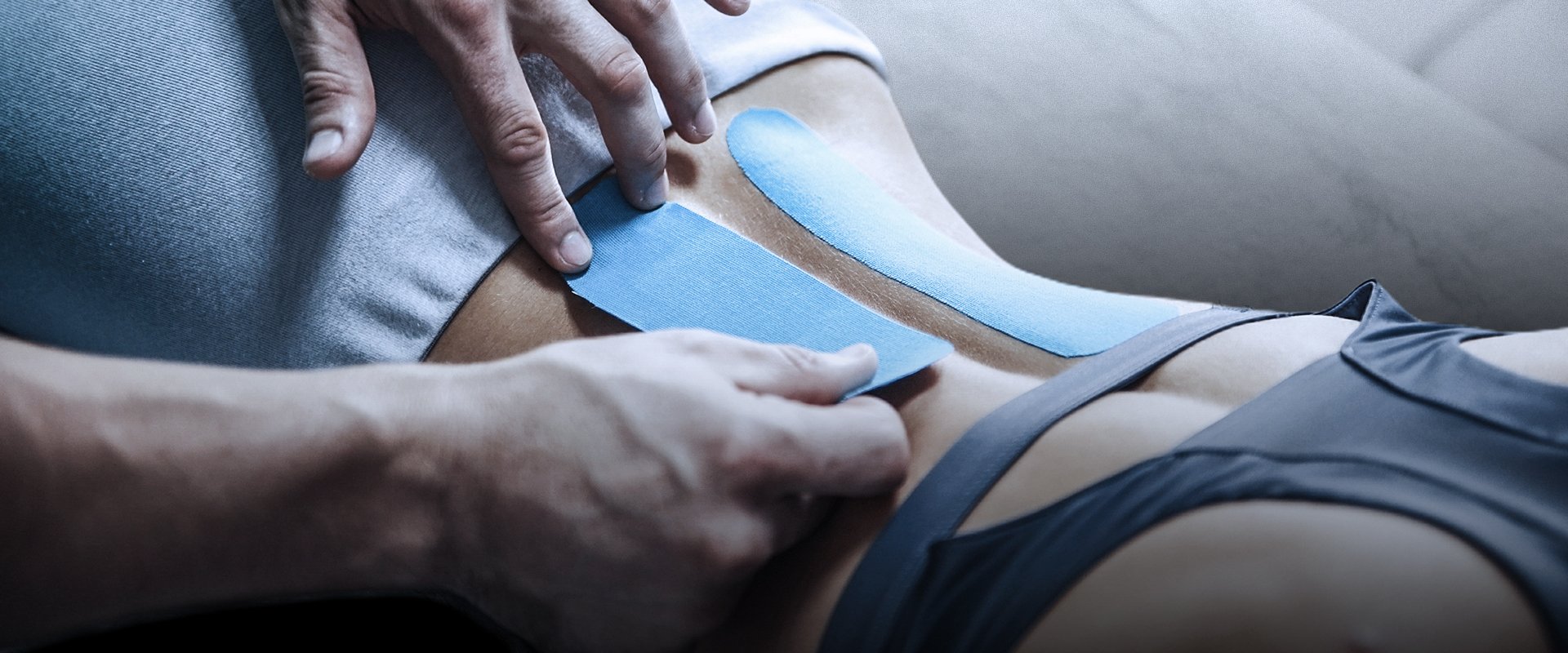
Physical Therapy and Kinesio Taping for Back Pain
AT EVOLVE
Physical Therapy and kinesio taping for Back pain
WHAT IS KINESIO® TAPE?
If you have ever seen athletes wearing black, tan or brightly-colored tape on their shoulders, knees or ankles, you may be familiar with Kinesio Tape. Kinesio Tape is an elastic, therapeutic taping modality used in many different populations from young children to professional athletes. Kinesio Tape can be applied in many different ways using the Kinesio Taping Method and is intended to reduce inflammation, re-educate the neuromuscular system, promote healing, lymphatic drainage and good circulation to the area beneath the tape.
If you have a back injury or are experiencing strain or pain in the back with activity your physical therapist may opt to try a course of Kinesio Taping to determine if this modality works for you.
WHAT IS SPECIAL ABOUT KINESIO TAPE?
While there are several brands of therapeutic tape, Kinesio Tape has many attributes that make it special and effective for therapeutic taping. Below are some of these unique attributes:
Tape made of medical-grade acrylic adhesive and 100% cotton fibers
Latex-free and hypoallergenic
A line of tape specific for sensitive skin
Water resistant with multiple-day wear capabilities
Variable tape tension meant to stimulate or relax muscles
Elasticity which mimics that of skin so it does not limit range of motion
When used on the back, the tape is often applied in an “I”, “X” or “Y” pattern over the targeted muscle or tissue though other patterns may be used as well. When placed over the skin, the tape is meant to lift the skin microscopically to create more space underneath which helps reduce inflammation and promotes flow of lymphatic fluid and blood. It can also help reduce pain, relax overused or tired muscles or stimulate muscle function.
Patients with swelling from a contusion on their back, for example, might use Kinesio Tape to encourage the flow of edema and bruising out of the tissues. A taping pattern that looks somewhat like a jellyfish is often used in this application. A patient recovering from a stroke or spinal cord injury also might use Kinesio Tape on the muscles around the spine to promote muscle activation.
Kinesio Tape has three zones. The anchor is the first spot where the tape is applied to the skin. At the other end of the tape is the base. The therapeutic zone lies between the anchor and the base. The tension or stretch of the tape can be modified and customized to achieve different results. This is why knowledge of how to apply the tape correctly and effectively matters. Your clinician can change the effect of the therapeutic zone by stretching the tape more or less or aligning it in a different direction.
HOW CAN KINESIO TAPING TECHNIQUES HELP MY BACK?
The Kinesio Taping Method was developed by Dr. Kenzo Kase in 1979 as a therapeutic method of taping to provide not only external support to tissues but also to help rehabilitate injuries and address physiologic dysfunction. Therapists using Kinesio Tape on your back will first assess your specific needs and impairments to determine the location, shape, and direction of taping and the amount of stretch. The assessment also determines what other interventions will be utilized alongside the Kinesio taping. Kinesio Taping is typically one of several interventions your physical therapist will administer to address your concerns.
Kinesio taping may be used to address many different concerns in the back. It is typically part of a comprehensive rehabilitation program to reduce pain and inflammation, relax or stimulate muscles and promote lymphatic flow. Given the goals of this taping technique, you may benefit from Kinesio Taping if you are recovering from a back injury or participating in work or sport-related tasks that might strain or work the muscles of the back.
If you are experiencing pain, inflammation or injury to the back area you might benefit from the application of Kinesio Tape. While this is not a complete list, here are some conditions or scenarios that might indicate the use of the Kinesio Taping Method on the back:
- Contusions, hematomas or large bruises on the back
- Low back pain
- Overactive or underactive muscles around the spine
- Neuromotor control impairments
- Back muscle strains
- Tendonitis or tendinopathy of the back muscles
- Pediatric neurologic conditions
- Adult neurologic conditions
End Injury Progression
Physical Therapy and Kinesio taping for back issues has proven to prevent injury, slow and even stop pain issues, improve performance, and reverse injury progression in many cases.
Relieve Pain
The movements used in this technique can target your entire body helping you to manage discomfort and pain during the course of your physical therapy treatments.
Improve Range of Motion
Posture awareness is an important area to focus on due to the fact that certain positions may cause you further discomfort and pain.
Restore Mobility
You can regain mobility and flexibility by taking part in the stretches and exercises as prescribed by your physical therapist.
How Long Will Physical Therapy and Kinesio Taping Last?
If you decide to work with a physical therapist to help correct your back issues, your entire treatment plan could consist of around 8-20+ different physical therapy sessions that will each last 60-90 minutes. Once you complete your customized physical therapy treatment plan, you will be able to continue to do the prescribed stretches and exercises utilized during your PT sessions yet in the comfort of your own home.
AM I A GOOD CANDIDATE FOR KINESIO TAPE?
Though Kinesio Tape was designed for use in many different populations and to treat many injuries and conditions, it is not always indicated or necessary. When you meet with your physical therapist you should mention your interest in Kinesio Tape. From there, they can advise you on how it might fit into a larger treatment plan. Even Dr. Kase, the inventor of Kinesio Tape, encouraged therapists to perform a full examination to identify other interventions needed to treat their patients. Kinesio Tape is usually just one part of a larger care plan for your back.
Tape is often used temporarily to help facilitate healing and reduce inflammation or pain. That being said, one benefit of Kinesio Tape is that after identifying the optimal application strategy for your symptoms, PTs will sometimes teach you how to apply it on your own, allowing you to access the effects of taping when needed. Athletes like pitchers, volleyball or tennis players or individuals who perform repetitive back movements for their jobs might apply Kinesio Tape during competitions or when working to help manage symptoms.
Kinesio Tape can be a helpful addition to your physical therapy plan of care to address back conditions such as low back pain or strain, muscle contusions, and so much more. Finding a Kinesio Taping Technique-trained therapist is the first step to accessing this treatment.
My team of therapists at Evolve Physical Therapy would love to discuss your interest in Kinesio Tape and educate you on how we can help address your back concerns with tape or the many other helpful techniques in our toolboxes. If you are experiencing back pain, injury, weakness or inflammation, call Evolve Physical Therapy today to schedule an initial evaluation.
Mill Basin (located in Harbor Fitness)
6161 Strickland Ave
Brooklyn, NY 11234
Monday: 7am-8pm
Tuesday: 7am-8pm
Wednesday: 8am-5pm
Thursday: 7am-8pm
Friday: 8am-1pm
Park Slope (located in Harbor Fitness)
550 5th Ave.
Brooklyn, NY 11215
Monday: 9am-8pm
Tuesday: 8am-6pm
Wednesday: 9am-8pm
Thursday: 8am-6pm
Friday: 8am-3pm
Gravesend
372 Avenue U
Brooklyn, NY 11223
Monday-Thursday: 8am-8pm
Friday: 8am-3pm
Kings Highway
945 Kings Highway
Brooklyn, NY 11223
Monday-Wed.: 12pm-8pm
Ready to take the next step to a healthier you?
Contact Us Today!
PHYSICAL THERAPY AND BACK KINESIO TAPING
Need physical therapy and kinesio taping for back pain?
Let our caring and compassionate physical therapists help you with relieving pain while getting you back on your feet comfortably.
Call now to schedule your first PT consultation free of charge.
Call: 1-718-751-0741







